The 1960s and ’70s were the age of the TV sitcom. Find a couple of mischievous, compelling characters with some irrevocable differences, then throw them together in a set made of papier-mache with a generous sprinkling of canned laughter for good measure.
Stand back and watch the comic sparks fly.
One of the most popular of those sitcoms in the UK was entitled Never Mind the Quality, Feel the Width. It featured two tailors, one Jewish, the other an Irish Roman Catholic.
In ‘The Not-So-Kosher Cantor’, the Irishman is railroaded into impersonating a cantor at a synagogue. He is discovered by the rabbi:
Rabbi: “It was what you did at the end of the service which made me suspicious.”
Patrick Kelly: “What did I do?”
“Well, you genuflected and made the sign of the cross.”
“It’s hard to break the habit of a lifetime, you know.”
Cue the canned laughter. Because it’s a comedy, all the differences are resolved with a laugh and an arm around the shoulder, in a spirit of playful irreverence. Nothing is ever allowed to become deadly serious.
At the Gold Coast on Friday evening, the Reds showed you don’t always have to sacrifice quality in the pursuit of attacking width on a rugby field. The unspoken rule is that only New Zealand teams can do this consistently, but against the Western Force at least, Queensland proved to be well up to Kiwi standard.
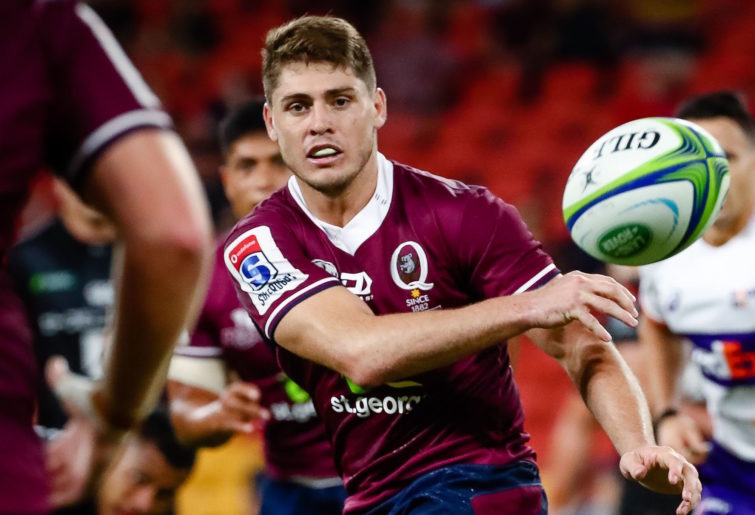
(Photo by Patrick HAMILTON / AFP via Getty Images)
Creating width on a rugby field is not about flinging the ball around with abandon. By itself, not even crisp and accurate passing is enough to generate overlaps in the modern game.
The key to attacking success in the wide channels nowadays is the ability to construct an imbalance in the middle third of the field. Defenders who want to stay in the safe thicket of forwards there have to be drawn out into space, where they will be most vulnerable to exploitation. The process takes time, precision and a lot of patience.
A couple of weeks ago, I examined the rival claims of the Brumbies’ Allan Alaalatoa and Reds’ Taniela Tupou to the starting tighthead prop berth for the Wallabies.
Since then, Tupou has exploded into action on both sides of the ball. He put in a mighty defensive shift in a rearguard action against the Rebels, while on Friday evening it looked like his attacking role had been very much more clearly defined and actualised by Queensland coaching wizard Jim McKay.
In the previous article, I noted that Tupou tends to be used off the flyhalf, rather than off the scrumhalf like Alaalatoa. This is unusual for a prop, but perhaps not so unusual for a centre trapped in a prop’s body.
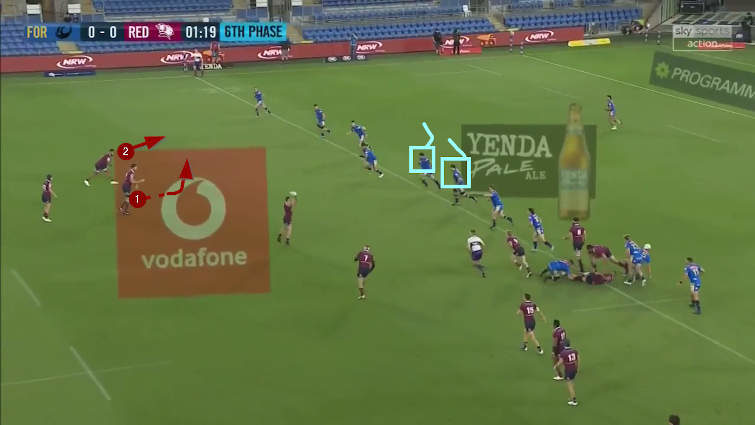
Here is the basic set-up as the ball bounces back in off the far sideline. There are two forwards beyond the first receiver (James O’Connor) but they are positioned so that only the outside man of the two can receive the ball. McKay wants the Tongan Thor on the ball, not his partner Angus Blyth.
Now take a look at the defence facing them. There are two backrowers in direct opposition (Fergus Lee-Warner and Kane Koteka), but it is really the two tight forwards inside them (Jeremy Thrush and Kieran Longbottom in the blue squares) that the Reds are trying to expose.
When Tupou receives the ball, he takes a step to the outside to absorb both Lee-Warner and Koteka at the tackle. This means both Longbottom and Thrush will be stretched to run all the way to the far side of the ruck to defend against the next play:
Thrush and Longbottom are overrun by the combination of Harry Wilson, O’Connor and Fraser McReight, who has made a sprint from the right-hand side of the field (in the screenshot) to provide inside support. That’s how wide attacking overloads are done.
The use of Tupou outside first receiver also found the Force in the process of a defensive regrouping for the first ‘try’ of the game, later reversed for a knock-on at the tackle:
The extra pass from Brandon Paenga-Amosa finds a seam which Tupou can run into, with Richard Kahui conveniently running out of the same hole to join his fellow backs further out.
Tupou was even employed as a runner in midfield from short first-phase lineouts, with his mates Wilson and McReight for company:

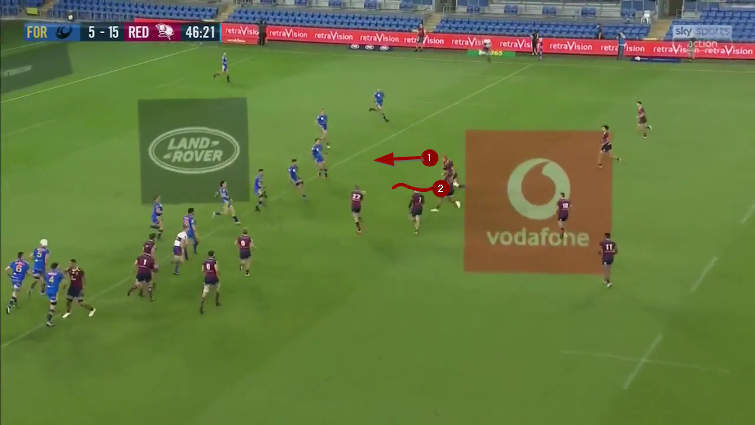
The idea is to get those Force tight forwards working harder than they would want to get around the first ruck, with a full hand of Queensland backs still in the frame on second phase.
The other advantageous aspect of having a forward ball-carrier as dynamic as Tupou on the end of the second pass is that he is much more likely to find that sensitive area called the ‘transition zone’ – the area policed by the last forward and the first back:
Tupou is running the hole in between number 10 Jack McGregor and second-rower Ollie Atkins (in the white headgear). He found the same vulnerable area when making a break and offload in the second period:
It’s the same set-up as in the first example from Queensland’s first attack of the game. Tupou is playing in tandem with Angus Blyth, but only one of them is the intended receiver – and it isn’t Blyth!
Thor takes the first step to the outside to get around the attempted tackle of Lee-Warner, and that draws the first back (number 12 Henry Taefu) into a tackle he can’t make against an offload he cannot prevent:
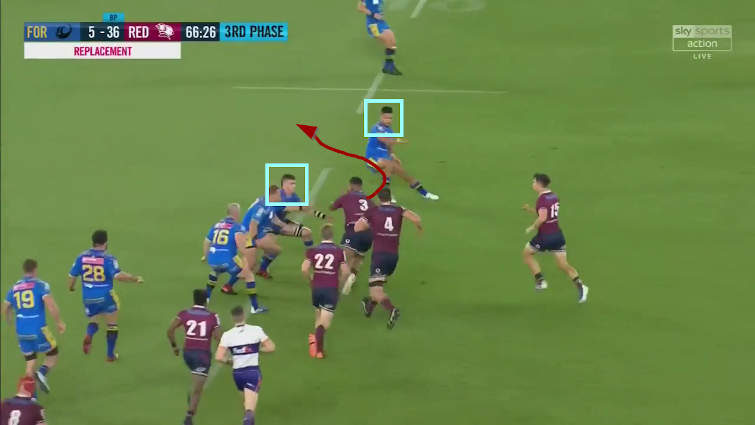
After the break is made, the Reds’ support out wide (headed up by McReight) will be far too quick for the Force cover.
The Force defence was conspicuously unable to put enough of a dent in Taniela Tupou to stop Queensland doing what they wanted to do on attack. On this occasion, it is the offload to Bryce Hegarty circling around behind him for a second touch:
Another long pass from Queensland’s other outstanding ball-handling tight forward, Lukhan Salakaia-Loto, provides immediate width to the left edge of the field. If the pass doesn’t go forward, the Reds are already in business with Filipo Daugunu in possession and Wilson on the inside track in support:

Ironically, the most clear-cut example of the Reds’ ability to develop attacking width didn’t involve the man who had been so influential in engineering it throughout the match.
Before the tackle on Hegarty is made, both Fergus Lee-Warner and Jeremy Thrush are well ahead of Fraser McReight and Harry Wilson. At the critical moment on the next play as play moves towards the right sideline, it is McReight who is in position A1, with Wilson still in close attendance:

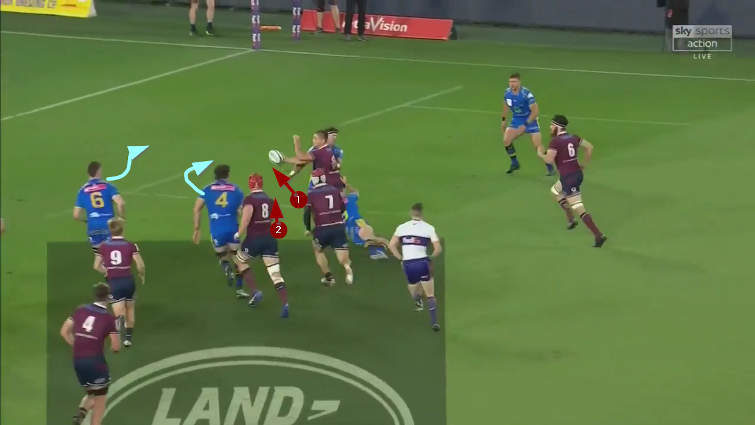
Summary
How do you reconcile the differences of an Irish Roman Catholic and a Jewish tailor? By putting them both in the same situational comedy.
How do you achieve attacking width on a rugby field without sacrificing the quality of your passing and running? By getting your forwards to run the difficult holes in midfield, which enables your superiority in support out wide to show. You get the width by finding the quality, and the accuracy inside.
The Queensland Reds’ attacking supremo Jim McKay has certainly found a way to get the most out of Taniela Tupou’s unique combination of speed, power and ball-handling skills in the middle of the field. His ability to do something other than plough straight ahead as a ball-carrier prised open the spaces which only James O’Connor and Fraser McReight could enjoy.

(Photo by Chris Hyde/Getty Images)
The Force picked a man who had previously been selected in the second row for the number 6 role against the Reds. Although they had enough beef to convert one close-range lineout driving attempt, defensively they lost control of the wide channels, and that mattered far more.
The Queensland back-row of McReight, Harry Wilson and Liam Wright enjoyed the kind of field day on offence that they had experienced without the ball against the Rebels.
In the process, the Tongan Thor may just have nosed ahead of Allan Alaalatoa as Dave Rennie’s preferred choice for the Wallaby no.3 jersey. Whether that is the truth or not only Rennie will know, but Tupou has put up his hand in a big way over the past two weeks.
It promises to be a monumentally unholy showdown when the Brumbies pitch up to Brisbane on September 5. That contest between the two best sides in Australia will be no laughing matter at all, and the smiles will be few and far between.





































































































